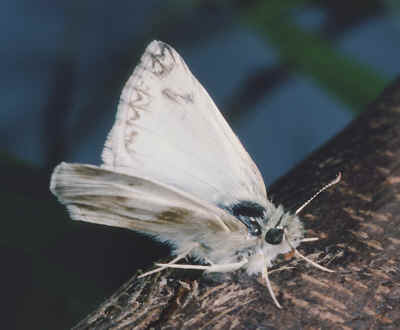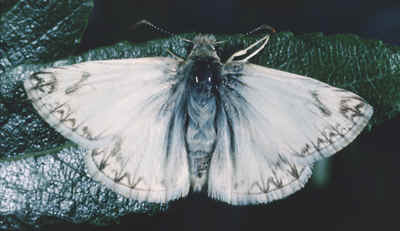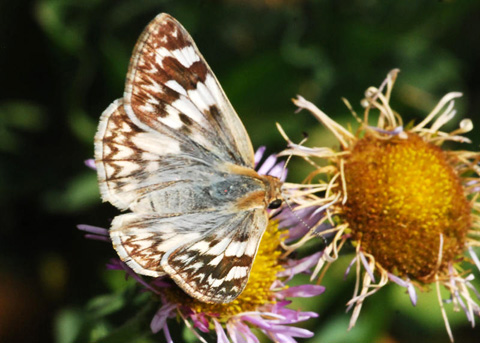 Male. Santiago Truck Trail, Orange County, CA. 4/25/09. © Peter J. Bryant |
Northern White Skipper Heliopetes ericetorum Lepidoptera: Hesperiidae Back to Butterflies of Orange County, California |
 Male. © Peter J. Bryant and Jack N. Levy. |
 Male. © Peter J. Bryant and Jack N. Levy. |
 Female. Fullerton Arboretum, Fullerton, Orange County, CA. 8-28-10. © Ron Hemberger |
 Female. Fullerton Arboretum, Fullerton, Orange County, CA. 8-28-10. © Ron Hemberger |
Characteristics: Male--predominantly white in color, with marginal brown "zig-zag" markings. Female--extensive brown markings on a cream-colored background. Forewing length: 16-19 mm). SimilarSpecies: This butterfly is similar in general appearance, but much larger than the Western Checkered Skipper (Pyrgus albescens). The ventral wing patterns of the two species also differ. Habitats, Behavior: A fast-flying species. It is often observed flying swiftly down small gullies, fairly low to the ground, occasionally stopping to nectar on Salvia mellifera (Black Sage) blossoms. In the Tehachapi Mountains, adults are occasionally found nectaring at Watercress (Rorippa nasturtium-aquaticum), Wild Buckwheat (Eriogonum fasciculatum), and fremontia (Fremontodendron sp.). Distribution: Only scattered records exist for this butterfly's occurrence in Orange County. It is reasonably common in the foothills northwest of Villa Park Dam, particularly in April and late summer (August and September). Theodore Hower also reports it from Trabuco Canyon. Flight Period: There are at least two broods, flying from April to October. Larval Foodplants: Mallows (family Malvaceae). Emmel and Emmel (1973) list the most common host as probably being Bush Mallow (Malacothamnus fasciculatus) which occurs occasionally throughout disturbed areas in the chaparral plant community and montane areas of Orange County (Boughey, 1968). This plant is common in the Villa Park Dam area. Other Remarks: In Orange County the butterfly generally occurs in the foothills and canyons of the Santa Ana Mountains. It probably also resides in the Brea foothills, althoughits presence in the rather dense chaparral of the higher elevations of the Santa Ana Mountains is doubtful, due to an apparent absence of the bush mallow foodplant. From Orsak, L. J. (1977). The Butterflies of Orange County, California. Center for Pathobiology Miscellaneous Publication #3. University of California Press, New York. 349pp. Return to Butterflies and their larval foodplants |
|
